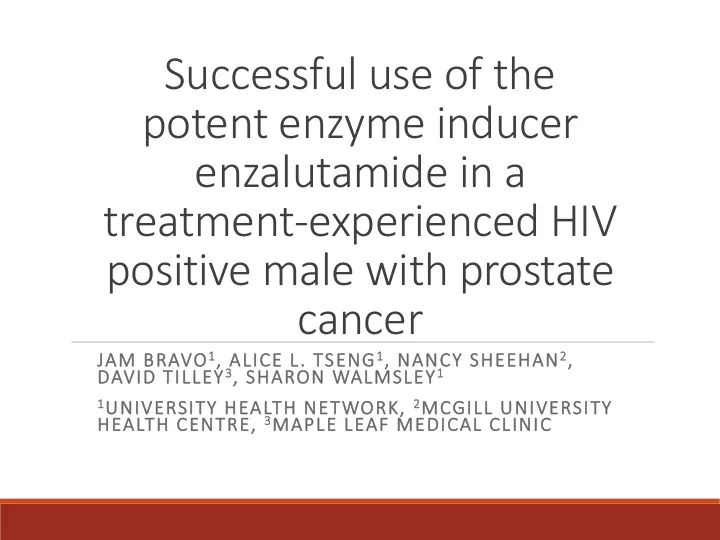

Successful use of the potent enzyme inducer enzalutamide in a treatment-experienced HIV positive male with prostate cancer JAM BRAVO 1 , , ALICE L. TSENG 1 , , NANCY SHEEHAN 2 , , DAVID TILLEY 3 , , SHARON WALMSLEY 1 1 UNIVERSITY HEALTH NETWORK, 2 MCGILL UNIVERSITY HEALTH CENTRE, 3 MAPLE LEAF MEDICAL CLINIC
Disclosure None
Background Therapeutic Drug Monitoring (TDM) is a strategy used to guide dosing of certain drugs, particularly those with narrow therapeutic window, to ensure likelihood of achieving favourable safety and efficacy outcomes 1 Certain ARVs such as NNRTIs and PIs meet the criteria suitable for a TDM strategy 2 (e.g. direct relationship between plasma concentration and efficacy/toxicity) Routine TDM is not recommended, but ARV concentration data may be useful in select clinical settings 3 Scenarios for consideration of TDM 3 : ◦ Treatment failure ◦ Special patient population: pediatrics and pregnancy ◦ Dose adjustment in context of organ dysfunction ◦ Suspected toxicity ◦ Monitoring of clinically relevant drug-drug interactions that may compromise antiretroviral effectiveness 1 Department of Health and Human Services July 2016 2 J Clin Pharmacol 2009;67(4):427-436 3 Can J Hosp Pharm 2009;62(6): 500-509
Background Enzalutamide is a pure androgen receptor signaling inhibitor used in metastatic, castration-resistant prostate cancer 4 • Strong inducer of CYP3A4 (86% ↓midazolam AUC) and moderate inducer of CYP2C19 (70% ↓omeprazole AUC) and CYP2C9 (56% ↓S -warfarin AUC) • Also induces CYP2B6, UGT1A1 and UGT1A4 Co-administration of enzalutamide with ARVs that are substrates of these enzymes could result in significant reductions in ARV plasma exposures, possibly leading to virologic failure and development of resistance 4 Xtandi (enzalutamide) Product Monograph 2016
Purpose To describe the successful use of enzalutamide in an HIV treatment- experienced patient with significant antiretroviral resistance
Case 57 year old treatment-experienced HIV-positive Caucasian male diagnosed in 1988 Treated with variety of antiretroviral regimens (mono/dual RTI, mega-HAART, enfuvirtide) • Various toxicities • Incomplete viral suppression despite patient adherence • Multiple viral resistance mutations: o NRTIs: high level resistance. NNRTIs: sensitive to etravirine, rilpivirine; resistant to efavirenz and nevirapine o PIs: high level resistance to all except for darunavir. o Viral load < 50 RNA copies/mL with CD4-count > 500cells/mm 3 since 2007 on the following regimen: • Darunavir 600mg/Ritonavir 100mg BID • Tenofovir/emtricitabine 300mg once daily • Raltegravir 400mg BID • Etravirine 200mg BID
Case Diagnosed with Gleason 4+5 prostate cancer with bone metastases • Failed bicalutamide and leuprolide Planned treatment with enzalutamide for castrate-resistant, metastatic prostate cancer Patient at risk of HIV treatment failure due to potent inducing effect of enzalutamide
Plan Drug Substrate Modification Darunavir CYP3A4, P-gp Increase ritonavir to 200 mg BID Etravirine CYP3A4, 2C9, 2C19 Maintain current dose, monitor Raltegravir UGT1A1 Switch to dolutegravir (CYP3A4, UGT substrate) with higher genetic barrier to resistance, give 50 mg BID Stepwise implementation: o December 2015: switch from RAL to DTG, obtain baseline TDM o January 2016: start enzalutamide 2 weeks later: increase ritonavir to 200 mg BID; Second TDM level o February & March 2016: TDM (4 weeks, 8 weeks) o Viral load testing: monthly for the first 3 months, then 2-3 months there after
Etravirine (ETV) 200mg BID Date of Indication Time Conc Interpretation Sample post- (mg/L) Status Dose (h) ◼ 2015-12-22 Baseline 7.75 0.88 Therapeutic ◻ 2016-01-18 Week 2 9.17 1.06 Therapeutic ▲ 2016-02-01 Week 4 9.50 1.01 Therapeutic △ 2016-02-29 Week 8 9.50 0.76 Therapeutic • Etravirine concentration at week 8 ~25% lower vs week 4 • Still above target concentration Population curve Cmin
Darunavir (DRV) 600/200mg BID Date of Indication # GIQ Time Conc Interpretation Sample mutations post- (mg/L) Status Dose (h) ◼ 2015-12-22 Baseline* 2 7.75 2.25 Subtherapeutic ◻ 2016-01-18 Week 2 2 9.17 3.06 Subtherapeutic ▲ 2016-02-01 Week 4 2 9.50 2.22 Subtherapeutic △ 2016-02-29 Week 8 2 9.50 2.04 Subtherapeutic *Patient was on 100mg BID ritonavir at baseline • 25 to 30% ↓baseline • All below target concentration for resistant viruses • However, concentration not seem to be associated with Population viral response if also on ≥ 2 active drugs 5 curve • We decided to continue with current dose Cmin 5 14 th International Workshop of Clinical Pharmacology of HIV Therapy, 2013
Dolutegravir (DLG) 50mg BID Date of Indication Time Conc Interpretation Sample post- (mg/L) Status Dose (h) ▲ 2015-12-22 Baseline 7.75 2.40 Therapeutic ◼ 2016-02-29 Week 8 9.50 2.67 Therapeutic • Week 8: • Baseline concentration lower prior to start of enzalutamide Population • Impact of enzalutamide induction not seen curve • Dolutegravir above Cmin Cmin
Case After 8 months of concomitant ARV and enzalutamide therapy ◦ Prostate-specific antigen (PSA) improved from 0.9 to 0.2 ◦ Viral load remained undetectable
Discussion Modification of therapy in anticipation of drug-drug interaction resulted in maintenance of virologic suppression in a treatment-experienced HIV patient with significant viral resistance Increasing ritonavir (thereby increasing CYP3A4 inhibition) counteracted the induction effect of enzalutamide on darunavir, etravirine, and dolutegravir The case presented is an example of a clinical setting where TDM played an important role in the management of ARV combination in a treatment-experienced patient with significant antiretroviral resistance
Conclusion TDM may allow successful use of interacting drugs in cases where antiretroviral choices are limited
Recommend
More recommend